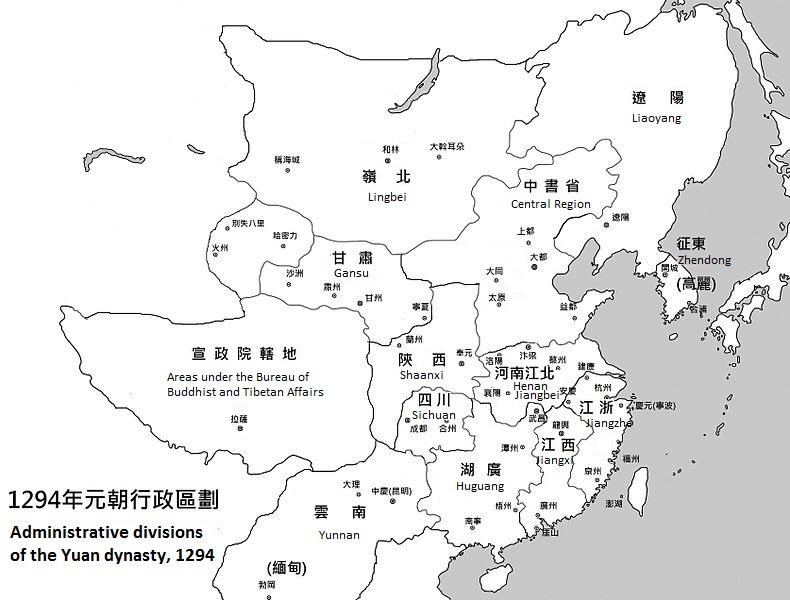|
Administrative Divisions Of The Yuan Dynasty
The Yuan dynasty was a Mongol-led imperial Chinese dynasty. During its existence, its territory was divided into the Central Region (Ķģ╣ĶŻÅ) governed by the Central Secretariat (Zhongshu Sheng) and places under control of various provinces (ĶĪīń£ü) or Branch Secretariats (ĶĪīõĖŁµøĖń£ü), as well as the region under the Bureau of Buddhist and Tibetan Affairs (Xuanzheng Yuan). In addition, the Yuan emperors held nominal suzerainty over the western Mongol khanates, but in reality none of them were governed by the Yuan dynasty due to the division of the Mongol Empire. Overview The most important part of the Yuan Empire was the Central Region, which covered the region of the Yuan capital Khanbaliq (Dadu, modern Beijing). The Central Region consisted of present-day Hebei, Shandong, Shanxi, the south-eastern part of present-day Inner Mongolia and the Henan areas to the north of the Yellow River. Since it was considered the most important region of the dynasty, it was directly governe ... [...More Info...] [...Related Items...] OR: [Wikipedia] [Google] [Baidu] |
Yuan Dynasty Administrative Division 1330
Yuan may refer to: Currency * Yuan (currency), the basic unit of currency in historic and contemporary mainland China and Taiwan ** Renminbi, the current currency used in mainland China, whose basic unit is yuan ** New Taiwan dollar, the current currency used in Taiwan, whose basic unit is yu├Īn in Mandarin ** Manchukuo yuan, the unit of currency that was used in the Japanese puppet state of Manchukuo Governmental organ * " Government branch" or "Court" (), the Chinese name for a kind of executive institution. Government of Taiwan * Control Yuan * Examination Yuan * Executive Yuan * Judicial Yuan * Legislative Yuan Government of Imperial China * Xuanzheng Yuan, or Bureau of Buddhist and Tibetan Affairs during the Yuan dynasty * Lifan Yuan during the Qing dynasty Dynasties * Yuan dynasty (Õģāµ£Ø), a dynasty of China ruled by the Mongol Borjigin clan ** Northern Yuan dynasty (ÕīŚÕģā), the Yuan dynasty's successor state in northern China and the Mongolian Plateau People and ... [...More Info...] [...Related Items...] OR: [Wikipedia] [Google] [Baidu] |
Tibet Under Yuan Rule
Tibet under Mongol rule refers to the Mongol Empire and Yuan dynasty's rule over Tibet from 1244 to 1354. During the Yuan dynasty rule of Tibet, the region was structurally, militarily and administratively controlled by the Mongol-led Yuan dynasty of China. In the history of Tibet, Mongol rule was established after Sakya Pandita got power in Tibet from the Mongols in 1244, following the 1240 Mongol conquest of Tibet led by the Mongol general with the title ''doord darkhan''. It is also called the Sakya dynasty () after the favored Sakya school of Tibetan Buddhism. The region retained a degree of political autonomy under the Sakya lama, who was the ''de jure'' head of Tibet and a spiritual leader of the Mongol Empire. However, administrative and military rule of Tibet remained under the auspices of the Yuan government agency known as the Bureau of Buddhist and Tibetan Affairs or Xuanzheng Yuan, a top-level administrative department separate from other Yuan provinces, but still u ... [...More Info...] [...Related Items...] OR: [Wikipedia] [Google] [Baidu] |
Amdo
Amdo ( öam╦ź╦ź.to╦ź╦ź ) is one of the three traditional Tibetan regions, the others being U-Tsang in the west and Kham in the east. Ngari (including former Guge kingdom) in the north-west was incorporated into ├£-Tsang. Amdo is also the birthplace of the 14th Dalai Lama. Amdo encompasses a large area from the Machu (Yellow River) to the Drichu (Yangtze). Amdo is mostly coterminous with China's present-day Qinghai province, but also includes small portions of Sichuan and Gansu provinces. Historically, culturally, and ethnically a part of Tibet, Amdo was from the mid-18th century and after administered by a series of local Tibetan rulers. The Dalai Lamas have not directly governed the area since that time. From 1917 to 1928, much of Amdo was occupied intermittently by the Hui Muslim warlords of the Ma clique. In 1928, the Ma Clique joined the Kuomintang (Chinese Nationalist Party), and during the period from 1928 to 1949, much of Amdo was gradually assimilated into the Qingh ... [...More Info...] [...Related Items...] OR: [Wikipedia] [Google] [Baidu] |


